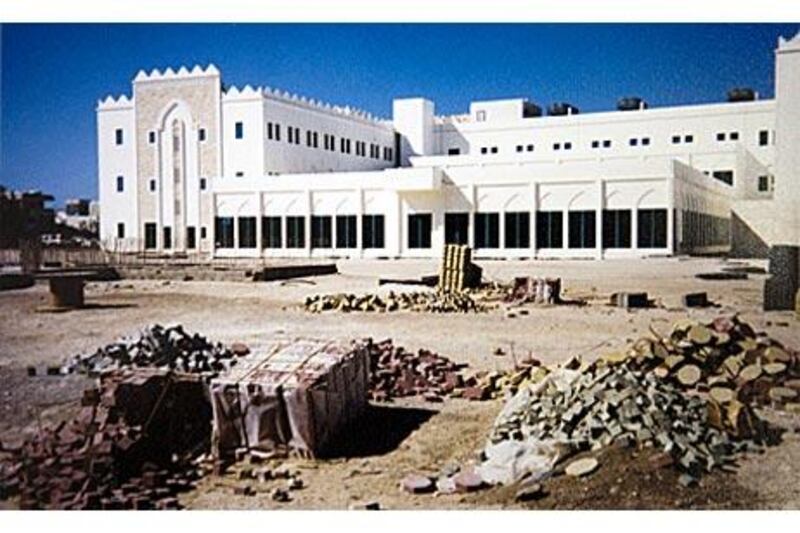ABU DHABI // When Dr Ali Khalil arrived in the capital from Canada, he was looking forward to the change in both his personal and professional lives. "Moving to the Middle East meant I would be closer to my home country, Lebanon, and my wife would be closer to her family," said the intensive-care specialist.
"At the same time, my kids, who were born and raised in Canada, would get to experience life in an Arab country." He was one of the first doctors to arrive, in February 2000, for a new project that has since become an integral part of the city: the founding of the Sheikh Khalifa Medical Centre, which this month celebrates its 10th anniversary. When the hospital - since renamed the Sheikh Khalifa Medical City - first opened its doors, it had just two beds in its intensive-care unit. Not only that, they doubled as its cardiac-care unit. It had just under 100 acute-care beds, a handful of staff and limited supplies.
"We did not have stocks of antibiotics, IV solutions, things like that," said Dr Khalil, who today works as the hospital's consultant endocrinologist. "We used to send cabs to pick up the stuff we needed each day from American Hospital in Dubai. "The cab driver would go in the morning and come back after two hours, and our supplies would reach us day by day." Today, the unit he helped found has grown to 50 beds, comprising the adult and child intensive-care units, as well as a heart unit.
Originally under Canadian management, the new hospital did all its hiring in North America - with the result that as it opened, Dr Khalil was its only doctor of Arab origin. The situation is much healthier now, he said. "We have more people who speak the local language and can communicate with patients better. We have people from Europe, Australia, India, the UK, not only North America. "Now we even have Emirati physicians in positions of leadership and as heads of division."
The heads of the cardiac-science programme, as well as the ophthalmology and orthopaedic departments, are Emiratis. Dr Khalil, together with the consultant haematologist Dr David Spence, who arrived in December 1999, and Dr Michel Giguere, head of maxillofacial surgery, who arrived in May 2000, have seen their small hospital grow to its current capacity of more than 600 beds. It now has 12 specialised outpatient clinics, as well as nine primary health care centres across the capital, and more than 4,000 staff.
A 120-bed Behaviour Sciences Pavilion and a 90-bed rehabilitation centre also have been added. All of the expansion, according to Dr Giguere and Dr Khalil, has turned the hospital into a highly sophisticated facility. But it has led to the demise of a close-knit family environment among staff that characterised those early months. All the doctors and some nurses were housed in three of the Corniche Tower buildings in Khalidiya.
"Not only did we use to meet up at work for a coffee or lunch together, but in the evening we got together as well," Dr Khalil said. "Our children played with one another and our wives shopped together. "That family feeling is gone now. Many families started moving out of the apartments and we no longer live in proximity - we are spread all over the city and don't mix like we used to." There have been some constants. Dr Giguere considers himself lucky to have kept a specialist nurse, Nurse Maria, since 2001. And his current office is just down the hall from the one he occupied 10 years ago. These details, he said, help the hospital still feel like home despite the changes.
"The faces are all new to me. It used to be a place where I would stop to talk to every person I passed in the corridors and just sit in the cafeteria and catch up and joke with colleagues," Dr Giguere said. "Now we are as big as any internationally renowned hospital, with healthcare facilities and clinics all over the city, constantly growing." Dr Spence said that although the hospital started small, the changes were rapid and profound.
"We have in past 10 years gone from an empty building with dust in the corridors to one of the busiest hospitals in the country," he said. The biggest growth spurt came in 2005, when the hospital merged with two others - Al Jazeerah Hospital and Central Hospital - to become today's "medical city". Overnight, hospital capacity more than doubled, from 200 beds to 450. Dr Khalil remembers the merger as a stressful time: "Health authorities decided over a weekend to make the merger and to unify services, and whether it is done aggressively over a weekend or over a few months, it had to be done."
Having set up his department as a "one-man show", Dr Giguere recalled: "Suddenly, we were dealing with patients of all nationalities, not just nationals, and when insurance became mandatory for all in Abu Dhabi, everything changed even more." Today, looking down from his office window, Dr Giguere sees an overflowing car park. "Before, the parking lots were empty," he said. "Our hallways and clinics and waiting rooms were empty. Now they are not just full, they are over full. We need to expand to keep up."
Dr Khalil said: "How far we've come, and the way things have evolved very fast, is something that is very pleasing. "We have many residency programmes, in surgery and paediatrics and soon in ophthalmology, all of which are flourishing. "We are training interns, we have support and education programmes, and we didn't have any of that in the beginning." Now, says Dr Spence, the future of the hospital lies in the hands of Emiratis. "They are really excellent and talented," he said. "They will be the key factor in enhancing health care and pushing it forward." @Email:hkhalaf@thenational.ae





